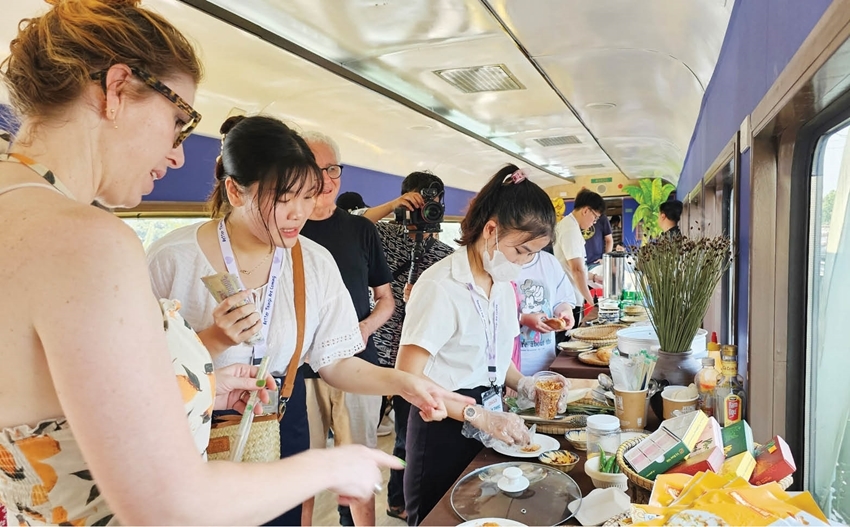After a lot of considerations, Hue City finally chose cuisine to build the application to submit to UCCN. This decision is agreed and supported by many people who believe that after Hanoi, Hoi An, and Da Lat, Hue will become a member of UCCN and contribute to spreading Vietnamese culture further.
 |
| Tourists exploring Hue specialties right on the train route named “Connecting Central Heritage” linking Hue City to Da Nang |
Choosing cuisine - A strong point of Hue
Being the capital of Dang Trong (the Inner Realm) for more than 300 years and then the capital of Vietnam, Hue housed “exotic delicacies” in the world as well as talented cooks from all over the country. Referring to Kinh Ky (capital area) cuisine, people will think of a huge list of 1,700 dishes that have been inventoried and investigated. It can be seen that these dishes are basically divided into three categories, including folk cuisine, royal cuisine and vegetarian cuisine.
Dr. Tran Dinh Hang, Director of the Vietnam National Institute of Culture and Arts in Hue, said that culinary cultural heritage clearly reflected human behavior towards the living environment. Hue went from being a border area to becoming a palace, and then the capital under the reigns of Nguyen lords - Tay Son - Nguyen Emperors. Therefore, Hue culinary culture, converged the essence everywhere, and then was spread outwards. Founded on local Southern elements, while at the same time, originating from the North and the West, it has a unique, quintessential traditional identity value.
Hue cuisine acts as a foundation that creates difference, pride, and attractiveness for Hue tourism according to the theory of cultural identity and product differentiation. When approaching Hue cultural heritage in the direction of developing cultural industry, cuisine is considered an important field since it harmoniously solves the relationship between cultural heritage and tourism products. In order to systematize and update the most complete research results and documentary information related to culinary cultural heritage, building a database of culinary cultural heritage is very practical.
An important element of Hue culture
According to Assoc. Prof, Dr. Nguyen Thi Thu Phuong, Director of the Vietnam National Institute of Culture and Arts, at present, based on initial and incomplete survey results, UCCN highly appreciates a number of criteria in Hue’s application with cuisine being the focus, and recognises it as a strong point that needs to be promoted. Therefore, it is necessary to promote the strength of “Vietnam's culinary capital” to position Hue as the focal point of Southeast Asian cuisine.
Along with that, based on the gastronomic diversity, with thousands of dishes having been inventoried and investigated to implement initiatives to internationalize Vietnamese dishes, “Hue chose the culinary field to join UCCN because this is one of the important elements of Hue culture, meeting the needs of society, while creating an opportunity to build an economic growth model associated with the development of cultural and human resources, and protecting the ecological environment”, shared Assoc. Prof, Dr. Nguyen Thi Thu Phuong.
Mr. Nguyen Huu Thong, a researcher in Hue, commented that once cuisine was conceived as an indispensable part when introducing a culture, it would no longer be purely about eating and drinking, yet it contains a depth of philosophy, aesthetics, and the process of inheritance and adaptation to the living environment, reflected in every corner. It also reflects the acculturation phenomenon of a community that was not the original inhabitants of this land.
According to Mr. Thong, Hue culinary culture is one of the unique and outstanding tourism products of this land. Therefore, to honor that unique tourism product, this is no longer the mission of just the chef, but requires the involvement of many people, many industries, and many other disciplines. It requires each dish and drink to appear on the dining table of tourists as an entity with a soul, conveying the profound voice of the philosophy of life and aesthetics of Hue culture and people. Realising this is probably not beyond our reach, but the decisive thing will come from an interdisciplinary project with a dedicated staff and a compatible funding source.
|
|
|
Vietnam currently owning 3 cities that are members of UCCN
UCCN aims to promote cooperation between cities that have identified creativity as a strategic element for sustainable urban development, promoting cooperation and sharing of experience among cities rich in culture all around the world. This organisation places creativity and cultural industries at the heart of urban development plans, encouraging investment in culture and creativity as a strategic lever for urban development.
Currently, Vietnam owns 3 cities recognized as members of UCCN, namely Hanoi (in the field of Design), Hoi An (in the field of Crafts and Folk Arts) and Da Lat (in the field of Music).
|